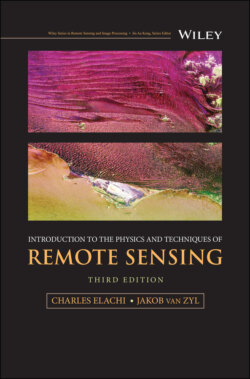Читать книгу Introduction to the Physics and Techniques of Remote Sensing - Jakob J. van Zyl - Страница 31
2.3 Generation of Electromagnetic Radiation
ОглавлениеElectromagnetic radiation is generated by transformation of energy from other forms such as kinetic, chemical, thermal, electrical, magnetic, or nuclear. A variety of transformation mechanisms lead to electromagnetic waves over different regions of the electromagnetic spectrum. In general, the more organized (as opposed to random) the transformation mechanism is, the more coherent (or narrower spectral bandwidth) is the generated radiation.
Radio frequency waves are usually generated by periodic currents of electric charges in wires, electron beams, or antenna surfaces. If two short straight metallic wire segments are connected to the terminals of an alternating current generator, electric charges are moved back and forth between them. This leads to the generation of a variable electric and magnetic field near the wires and to the radiation of an electromagnetic wave at the frequency of the alternating current. This simple radiator is called a dipole antenna.
At microwave wavelengths, electromagnetic waves are generated using electron tubes which use the motion of high‐speed electrons in specially designed structures to generate a variable electric/magnetic field, which is then guided into waveguides to a radiating structure. At these wavelengths, electromagnetic energy can also be generated by molecular excitation as is the case in masers. Molecules have different levels of rotational energy. If a molecule is excited by some means from one level to a higher one, it could drop back to the lower level by radiating the excess energy as an electromagnetic wave.
Higher frequency waves in the infrared and the visible are generated by molecular excitation (vibrational or orbital) followed by decay. The emitted frequency is exactly related to the energy difference between the two energy levels of the molecules. The excitation of the molecules can be achieved by a variety of mechanisms such as electric discharges, chemical reactions, or photons’ illumination.
Molecules in the gaseous state tend to have well‐defined, narrow emission lines. In the solid phase, the close packing of atoms or molecules distorts their electron orbits leading to a large number of different characteristic frequencies. In the case of liquids, the situation is compounded by the random motion of the molecules relative to each other.
Lasers use the excitation of molecules and atoms and the selective decay between energy levels to generate narrow bandwidth electromagnetic radiation over a wide range of the electromagnetic spectrum ranging from UV to the high submillimeter.
Heat energy is the kinetic energy of random motion of the particles of matter. The random motion results in excitation (electronic, vibrational, or rotational) due to collisions followed by random emission of electromagnetic waves during decay. Because of its random nature, this type of energy transformation leads to emission over a wide spectral band. If an ideal source (called blackbody) transforms heat energy into radiant energy with the maximum rate permitted by thermodynamic laws, then the spectral emittance is given by Planck’s formula as:
(2.36)
where h is Planck’s constant, k is the Boltzmann constant, c is the speed of light, λ is the wavelength, and T is the absolute temperature in degrees Kelvin. Figure 2.12 shows the spectral emittance of a number of blackbodies with temperatures ranging from 2000 K (temperature of the Sun’s surface) to 300 K (temperature of the Earth’s surface). The spectral emittance is maximum at the wavelength given by:
(2.37)
where a = 2898 μm K. The total emitted energy over the whole spectrum is given by the Stefan–Boltzmann law:
(2.38)
where σ = 5.669 × 10−8 Wm−2 K−4. Thermal emission is usually unpolarized and extends through the total spectrum particularly at the low‐frequency end. Natural bodies are also characterized by their spectral emissivity ∈(λ), which expresses the capability to emit radiation due to thermal energy conversion relative to a blackbody with the same temperature. The properties of this emission mechanism will be discussed in more detail in Chapters 4 and 5.
Figure 2.12 Spectral radiant emittance of a blackbody at various temperatures. Note the change of scale between the two graphs.
Going to even higher energies, waves in the gamma‐ray regions are mainly generated in the natural environment by radioactive decay of uranium (U), thorium (Th), and potassium 40 (40K). The radioisotopes found in nature, 238U and 232Th, are long‐lived alpha emitters and parents of individual radioactive decay chains. Potassium is found in almost all surfaces of the Earth, and its isotope 40K, which makes up 0.12% of natural potassium, has a half‐life of 1.3 billion years.
